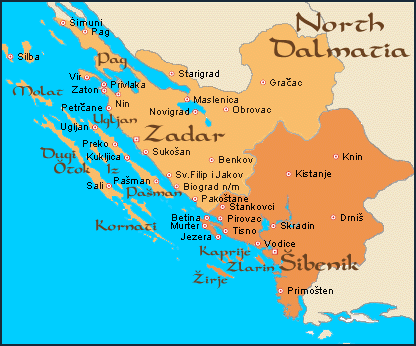
Croatia's Regions
For those who didn't know, Croatia (Hrvatska), is in the Balkans in Central Europe. It is a fascinating country, a bridge between the East and West, and a cross roads of many cultures and influences. It was colonised in ancient times by the Illyrians, Greeks and Romans, followed by the Celts, Croats (of course!), Venetians, Italians, Ottomans, Hungarians and Austrians, all of whom have left their mark (some of the best preserved examples of Roman architecture can be found in Croatia). From this melting pot of civilisations has developed a country with a character all its own.
Croatia is made up of five provinces: Slavonia, the furthermost inland, Central Croatia, the largest province, and Istria, Kvarner and Dalmatia, the coastal provinces, which include 1,185 islands on the Adriatic. The five insignia on the Croatian flag, incidentally, correspond to the five provinces.
Croatia can also be divided into geographical areas; continental, mountainous and coastal. These largely determine the climate, which can vary quite considerably across the country. Northern Croatia has a continental climate, Central Croatia has a semi-highland and highland climate, while the Croatian coast has a Mediterranean climate. Winter temperatures range from -1 to 3ºC in the continental region, -5 to 0ºC in the mountain region and 5 to 10ºC in the coastal region. Summer temperatures range from 22 to 26ºC in the continental region, 15 to 20ºC in the mountain region and 26 to 30ºC in the coastal region. Of course, in the mountains along the coast one can expect the temperature to be cooler. In fact, you can be sitting in a cafe on a sea front in Dalmatia during Spring, dressed in just T-shirt and shorts, and the mountain peaks behind you could be capped with snow! It's a very beautiful sight.
Most holiday makers will be going to Croatia for the sea, sunshine and beaches but one mustn't forget its inland attractions. Croatia, for instance, has 8 National parks overflowing with fauna and flora, forests, cascading waterfalls, rivers and deep blue lakes. Four of the parks are in the mountainous region (Risnjak, Sjeverni Velebit, Paklenica and Plitvice Lakes), and four are in the coastal region (Kornati, Mljet, Brijuni and Krka). There are about 450 000 hectares of protected natural assets (national parks, reservations, natural monuments, nature parks) in Croatia and 44 herbal and 381 animal species are protected. Over 400 bears roam wild in the mountain forests and wild sheep, mountain goats, wild cats, wolves and an abundance of lynx live happily here. The amount of bird life is too vast to mention! Of course, there are the various geological phenomena too - mountains, valleys, canyons, sinkholes, ravines, springs, gorges and caves, some unexploited.
Click on a region below to find out more:




